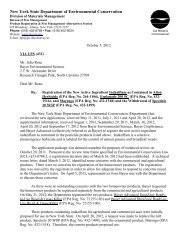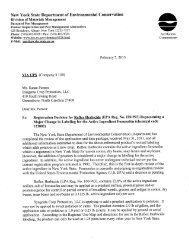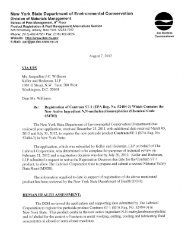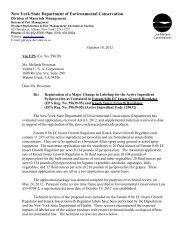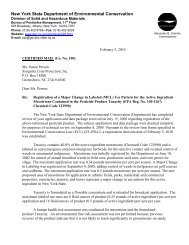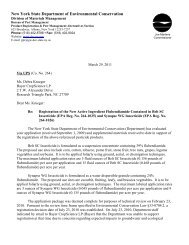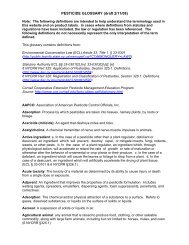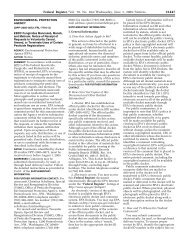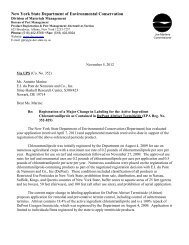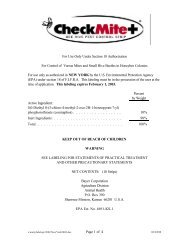Prothioconazole/Trifloxystrobin
Prothioconazole/Trifloxystrobin
Prothioconazole/Trifloxystrobin
You also want an ePaper? Increase the reach of your titles
YUMPU automatically turns print PDFs into web optimized ePapers that Google loves.
Ms. Karen Cain 2.<br />
fluid ounces of product (0.16 pounds of prothioconazole and 0.48 pounds of trifloxystrobin) per<br />
acre per year. Near the end of the technical review process, Bayer CropScience LP (Bayer)<br />
petitioned to add barley and wheat to the list of proposed crops. These crops were previously<br />
approved for prothioconazole but not trifloxystrobin. The proposed use rates for wheat and<br />
barley are less than or equal to the corn and soybean rates. In addition, corn and soybean acreage<br />
in New York State is several times higher than the acreage of wheat and barley in the State.<br />
Therefore, no additional review parameters were required for the wheat and barley use.<br />
The application package was deemed complete for purposes of technical review on<br />
January 27, 2011. Pursuant to the review time frame specified in Environmental Conservation<br />
Law §33-0704.2, a registration decision date of June 24, 2011 was established. Technical<br />
reviews of the proposed uses included on the Stratego YLD label have been performed by the<br />
Department and the New York State Department of Health. On June 2, 2011, the Department<br />
sent a “Technical Issues” letter to Bayer describing concerns with respect to the aerial<br />
application and chemigation methods of application described on the Stratego label. Bayer’s<br />
response was received by the Department on July 12, 2011. The Department has determined that<br />
Bayer’s response sufficiently mitigates the Department’s concerns. The technical reviews are<br />
shown below.<br />
HUMAN HEALTH ASSESSMENT:<br />
The following assessment was prepared by staff within the Bureau of Toxic Substance<br />
Assessment at the New York State Department of Health.<br />
On an acute basis, the formulated product Stratego YLD Fungicide was not very toxic<br />
via the oral, dermal and inhalation routes of exposure. This pesticide product did not cause skin<br />
or eye irritation (tested on rabbits) or skin sensitization (tested on guinea pigs).<br />
<strong>Trifloxystrobin</strong><br />
We have previously reviewed the active ingredient trifloxystrobin for the pesticide<br />
products Flint Fungicide and Compass Fungicide. The available information on trifloxystrobin<br />
indicated that it is not very toxic or irritating following acute exposures in laboratory animals,<br />
but is a strong skin sensitizer. Data from chronic and developmental/reproductive toxicity<br />
studies showed that trifloxystrobin has the potential to cause some toxicity, principally liver<br />
effects. The U.S. Environmental Protection Agency (U.S. EPA) classified this chemical as “not<br />
likely to be carcinogenic to humans” based on a lack of evidence of carcinogenicity in rat and<br />
mouse chronic feeding studies. The U.S. EPA Office of Pesticide Programs (OPP) established<br />
an acute oral reference dose (aRfD) for females 13–49 years of age of 2.5 milligrams per<br />
kilogram body weight per day (mg/kg/day) based on a no-observed-effect level (NOEL) of 250<br />
mg/kg/day from a developmental toxicity study in rats (increased fetal skeletal anomalies) and an<br />
uncertainty factor of 100. The U.S. EPA OPP additionally established a chronic oral reference<br />
dose (cRfD) for trifloxystrobin of 0.038 mg/kg/day based on a NOEL of 3.8 mg/kg/day from a<br />
two-generation reproductive toxicity study in rats (decreased body weight, body weight gain and<br />
food consumption; liver, kidney and spleen effects) and an uncertainty factor of 100. A current



